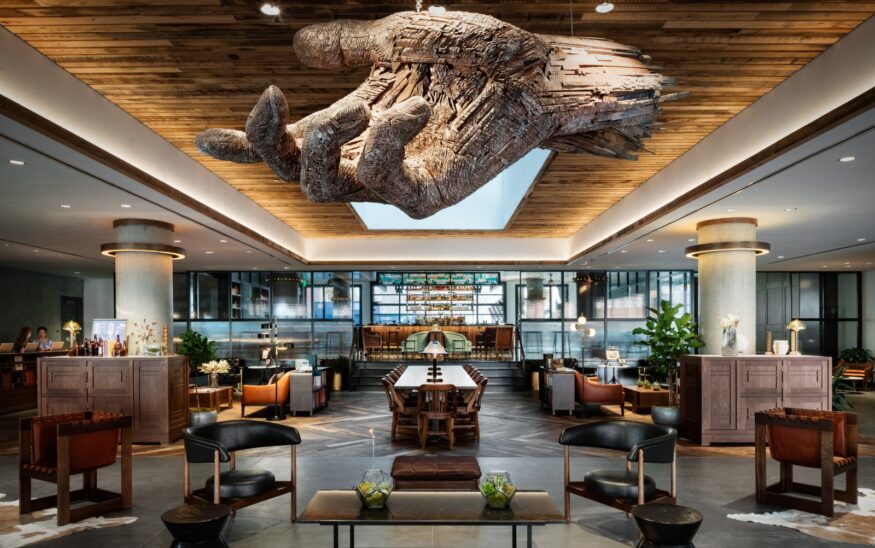The Era of Experience-Driven Hotel Design


The Era of Experience-Driven Hotel Design

It was 1891, and Denver was in the middle of the gold rush. Entrepreneurship abounded, and brewer Adolph Zang and his partners, Philip Feldhauser and William Mygatt, opened the doors to one of Denver’s most beloved landmarks: The Oxford Hotel, designed by architect Frank E. Edbrooke.
This extravagant and first-class vision provided travelers with a new kind of haven in the city. While the historic opulence of the hotel’s design still intrigues present-day travelers, there is also a modern-day lesson every architect and developer can take away from this treasure: It never ceases to provide guests with a distinct experience.
Like The Oxford in the early 1900s – and still today – modern hotels are once again becoming destinations in their own right, thanks to a new emphasis on the guest experience.
With the novelty of services like Airbnb wearing off and branded hotel product at market saturation level, the hospitality industry in Denver is undergoing a renaissance in the boutique/independent hotel sector. Travelers are seeking unique experiences, and smaller hotels that provide personalized services to guests are meeting the demand.
From independent owners to international corporate brands, hotels are built around local flavor – both in design and cuisine – creating new opportunities for architects and designers to think outside the box.
REDEFINING PUBLIC SPACES
In the first half of the 1900s, and especially in the roaring ‘20s, hotels were hot spots for out-of-towners and locals to mix and mingle in world-class restaurants and bars.
After World War II, however, a shift occurred in the hospitality industry. Purse-strings tightened, and the middle class was on the move. Roadside motels and efficiency concepts provided the bare essentials, with designs that revolved around little more than practicality.
While practicality is still a design emphasis today, urban hotels are once again becoming social and entertainment hubs for communities, calling for flexible public spaces that provide a destination for travelers while also integrating into the local ethos of a city and its neighborhoods. The space must be inviting, yet uncommon enough to transport people from their daily routines.
The Crawford Hotel at Denver Union Station, designed by JOHNSON NATHAN STROHE and Tryba Architects, and developed by Union Station Alliance (a partnership of Sage Hospitality, McWhinney, Urban Neighborhoods and Larimer Associates) delivers such an experience.

The hotel’s lobby doubles as Denver’s largest transportation hub – a 24/7 hustle and bustle of regional commuters, cross-country travelers and locals. This adaptive reuse project injected new life into an underutilized historic Amtrak station, converting the upper stories into guestrooms with open hallways that overlook the grand hall – “Denver’s living room” – with a diverse array of connected retail and restaurant choices.
Less than a mile away, The Maven Hotel at Dairy Block, designed by JOHNSON NATHAN STROHE and developed by McWhinney, Grand American and Sage Hospitality, takes public space to a new level. The 3,600-square-foot lobby of The Maven serves multiple purposes, connecting two local restaurants, the lobby of an adjacent office building, a flexible, modern event space and Denver’s first truly activated alley – which will feature artisan vendors and multiple dining concepts. Complete with open-air coffee and floral shops, this lobby creates a seamless flow between work and play to serve as the local hub for the neighborhood.
USING ART TO ENHANCE THE DESIGNED EXPERIENCE
Integrating a curated art program into a hotel’s design can create an unexpected immersive experience for guests, and pique their interest to revisit the space. Long gone are the days of generic motel art that hangs over beds and above tables in elevator bays. Curators, like Denver-based NINE dot ARTS, can source museum-worthy works that captures the spirit of the hotel and turn guest and public spaces into interactive galleries.
Working with art curators from the beginning of the project ensures the art integrates fully into the design, instead of being an after-thought. That was the case with JOHNSON NATHAN STROHE and NINE dot ARTS on the recently opened Moxy Denver Cherry Creek.

With 775 artworks and objects incorporated throughout the 170-room hotel, there’s a new surprise around every corner. The design and art work together to enhance the fun and funky millennial-minded concept that emphasizes social interaction.
LOCALIZING CORPORATE BRANDS
For a long time, boutique hotels were synonymous with independent properties. However, many corporate brands are seeing the demand for boutique experiences – and the growing operational efficiencies of independent hotels – making their move into the market. Shedding the predictable and often cookie-cutter design of their corporate brands, these new hotels are striving to provide loyal customers with a new kind of local experience.
Moxy Denver Cherry Creek is a boutique concept by Marriott that infuses the character of the surrounding upscale neighborhood while staying true to its “heart of a hostel” mentality. As the brand’s first foray into the Colorado market, this hotel is contextually designed with subtle homages to the area’s history of gold mining. Adding value to its neighbors, the hotel’s outdoor space is anchored by a beer garden featuring Colorado craft brews.

Other corporate brands in the area are also making strides to localize their experiences. In Boulder, two recently opened Hilton-branded hotels – Embassy Suites and Hilton Garden Inn, designed by JOHNSON NATHAN STROHE and developed by Sage Hospitality and NAI Shames Makovsky – offer 265,000 square feet of guest and public spaces that reflect Boulder’s character.
Spanning two prominent blocks along Canyon Boulevard, JOHNSON NATHAN STROHE met the need for high-quality urban design and architecture by using external materials such as stucco and red sandstone quarried from nearby Lyons. The hotels incorporate ground-floor retail, restaurants and open space as added amenities for the neighborhood, and also feature artwork from CU Boulder alumni and students.
With the rise of a distinct culture built on boutique hotels, craft beverages and artisan cuisine, the Denver metro area is no longer just a gateway to the mountains, but a must-experience metropolis that will continue to attract regional, national and international attention.













